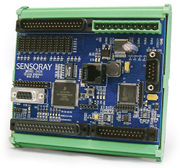Difference between revisions of "2426"
(created) |
(→Built-in servers) |
||
| (One intermediate revision by one user not shown) | |||
| Line 1: | Line 1: | ||
[[File:2426_photo.jpg|thumb|Model 2426]] | [[File:2426_photo.jpg|thumb|Model 2426]] | ||
[http://www.sensoray.com/products/2426.htm Model 2426] is a DIN rail mountable module that interfaces a variety of real world signals to Ethernet. It has eight isolated digital inputs, 16 digital outputs, six 12-bit analog inputs, one 12-bit analog output, an asynchronous serial port with RS-422/RS-485 phy, and a high speed incremental encoder interface, all powered by 24 VDC. | [http://www.sensoray.com/products/2426.htm Model 2426] is a DIN rail mountable module that interfaces a variety of real world signals to Ethernet. It has eight isolated digital inputs, 16 digital outputs, six 12-bit analog inputs, one 12-bit analog output, an asynchronous serial port with RS-422/RS-485 phy, and a high speed incremental encoder interface, all powered by 24 VDC. | ||
| + | {{clear}} | ||
| + | ==Built-in servers== | ||
| + | |||
| + | :''Can I use HTTP for automated control?'' | ||
| + | |||
| + | Model 2426 has built-in telnet and HTTP servers. Sensoray recommends Telnet for automated control and provides a comprehensive telnet-based API for this purpose. On the other hand, the HTTP server is intended to facilitate manual operation by a human operator (via web browser), and consequently there is no HTTP-based API or protocol documentation. | ||
| + | |||
| + | Having said that, it is possible for an automated HTTP client to read and program the IOs. In general, IO reads are done via HTTP GET methods and IOs are programmed via HTTP POST methods. You can see the HTTP message protocol in action. To do this, run a web browser in debug mode while you interact with the 2426 module. | ||
Latest revision as of 09:50, 3 March 2020
Model 2426 is a DIN rail mountable module that interfaces a variety of real world signals to Ethernet. It has eight isolated digital inputs, 16 digital outputs, six 12-bit analog inputs, one 12-bit analog output, an asynchronous serial port with RS-422/RS-485 phy, and a high speed incremental encoder interface, all powered by 24 VDC.
[edit] Built-in servers
- Can I use HTTP for automated control?
Model 2426 has built-in telnet and HTTP servers. Sensoray recommends Telnet for automated control and provides a comprehensive telnet-based API for this purpose. On the other hand, the HTTP server is intended to facilitate manual operation by a human operator (via web browser), and consequently there is no HTTP-based API or protocol documentation.
Having said that, it is possible for an automated HTTP client to read and program the IOs. In general, IO reads are done via HTTP GET methods and IOs are programmed via HTTP POST methods. You can see the HTTP message protocol in action. To do this, run a web browser in debug mode while you interact with the 2426 module.
